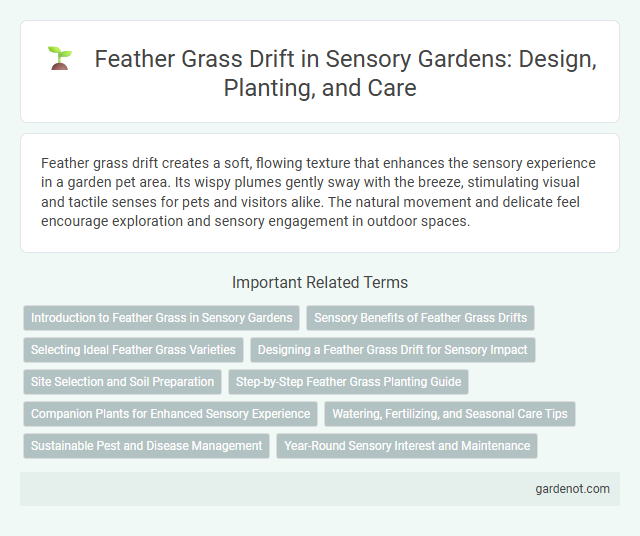Feather grass drift creates a soft, flowing texture that enhances the sensory experience in a garden pet area. Its wispy plumes gently sway with the breeze, stimulating visual and tactile senses for pets and visitors alike. The natural movement and delicate feel encourage exploration and sensory engagement in outdoor spaces.
Introduction to Feather Grass in Sensory Gardens
Feather grass, known for its delicate, flowing plumes, enhances sensory gardens by engaging multiple senses through its soft texture and gentle movement in the breeze. This ornamental grass thrives in well-drained soils and full sun, making it an ideal choice for creating tactile and visual interest. Its ability to sway gracefully adds dynamic motion, enriching the sensory experience and attracting wildlife such as butterflies and birds.
Sensory Benefits of Feather Grass Drifts
Feather grass drifts enhance sensory gardens by providing gentle tactile experiences through their soft, flowing plumes that respond to wind and touch. The movement and texture stimulate visual and tactile senses, promoting relaxation and mindfulness. Their whispering sound in breezes adds an auditory dimension that enriches sensory engagement and emotional well-being.
Selecting Ideal Feather Grass Varieties
Selecting ideal feather grass varieties for a sensory garden involves choosing species like Stipa tenuissima and Stipa gigantea, known for their soft, flowing plumes that enhance tactile experience. These varieties thrive in well-drained soil and full sun, making them low-maintenance and suitable for diverse climates. Incorporating different feather grass types creates visual movement and texture, enriching the garden's sensory appeal.
Designing a Feather Grass Drift for Sensory Impact
Feather grass drift enhances sensory gardens by creating dynamic visual movement and soft tactile experiences that engage visitors' senses. Strategic planting in flowing patterns amplifies auditory stimulation as rustling blades respond to the wind, enriching the garden's immersive ambiance. Utilizing varieties like Stipa tenuissima ensures year-round texture and subtle color variation, supporting both aesthetic appeal and sensory interaction.
Site Selection and Soil Preparation
Feather grass drift thrives best in well-drained, sandy or loamy soil with a slightly alkaline to neutral pH, making site selection crucial for optimal growth in sensory gardens. Choose a sunny location that receives full sun to partial shade, as Feather grass requires ample light to maintain its distinctive feathery texture and enhance sensory appeal. Prior to planting, prepare the soil by loosening it to a depth of at least 12 inches and incorporating organic compost to improve aeration and nutrient availability, ensuring healthy root development.
Step-by-Step Feather Grass Planting Guide
Plant feather grass in well-drained soil with full sun exposure to promote optimal growth and texture. Begin by loosening the soil and mixing in organic compost to enhance nutrient availability and moisture retention. Space each tussock 18 to 24 inches apart, ensuring proper air circulation and aesthetic drift formation.
Companion Plants for Enhanced Sensory Experience
Feather grass drift pairs exceptionally well with lavender and Russian sage, which amplify its soft textures and soothing fragrance, creating a multi-sensory garden environment. The fine, airy plumes of feather grass contrast beautifully with the sturdy, aromatic leaves of rosemary and thyme, enhancing tactile variation and inviting touch. Strategically incorporating ornamental herbs and flowering perennials alongside feather grass drift intensifies both visual appeal and aromatic stimulation, essential for a fully immersive sensory garden.
Watering, Fertilizing, and Seasonal Care Tips
Feather grass drift thrives in well-drained soil, requiring moderate watering to keep the roots moist without waterlogging. Use a balanced, slow-release fertilizer in early spring to promote healthy growth and vibrant plumes throughout the season. Prune the grass back to 4-6 inches in late winter to encourage fresh shoots and maintain its graceful appearance in a sensory garden.
Sustainable Pest and Disease Management
Feather grass drift, known for its drought tolerance and low maintenance, supports sustainable pest and disease management by enhancing biodiversity and attracting beneficial insects that naturally control pests. Its robust growth and resistance to common diseases reduce the need for chemical interventions, promoting an eco-friendly garden environment. Integrating feather grass drift in sensory gardens fosters resilience against pests while maintaining soil health and ecosystem balance.
Year-Round Sensory Interest and Maintenance
Feather grass drift offers year-round sensory interest through its graceful movement, soft texture, and changing hues from green to golden bronze, captivating sight and touch across seasons. This perennial grass requires minimal maintenance, thriving in well-drained soil with full sun exposure, and benefits from annual trimming in late winter to promote healthy growth and maintain its aesthetic appeal. Its drought tolerance and resilience make it an ideal, low-maintenance choice for enhancing sensory garden experiences.
Feather grass drift Infographic

 gardenot.com
gardenot.com